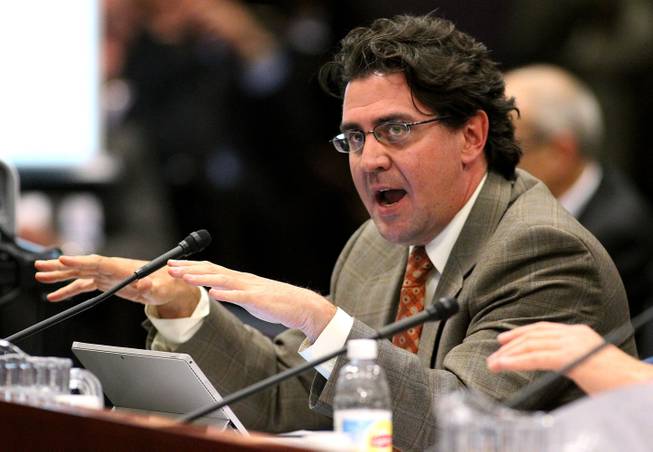
AP Photo/Cathleen Allison
Economic analyst Jeremy Aguero testifies about a compromise tax plan during a joint money committee hearing at the Legislative Building in Carson City on Thursday, May 21, 2015.
Tuesday, Feb. 14, 2017 | 8:25 p.m.
A property tax cap has cost governments in Nevada as much money in the last two years as was raised from new taxes and fees enacted in the last legislative session, said an economist at a joint meeting of the Senate Committee on Revenue and Economic Development and the Assembly Committee on Taxation at the Nevada Legislature Tuesday.
“Lots of legislators have expressed to me that it feels like they were making strides and attempting to get forward but it felt like we’re not always getting ahead,” said Jeremy Aguero, a principal of the economic analysis firm Applied Analysis.
Aguero was hired by a group of local governments in Nevada to examine property taxes and the cap, or abatement as it’s officially called, that was enacted in 2005 to provide tax relief to homeowners who, because of the housing bubble, were experiencing huge increases in property values.
The cap worked “exactly as it was intended to,” Aguero said, by slowing increases in property taxes during the boom. However, local governments have complained that since the economic recovery, the abatement has kept property taxes low even while demand for local services has risen.
During a lengthy and comprehensive presentation, Aguero detailed Nevada’s unique version of property taxes, how the tax cap works, the history of Nevada’s property taxes, and the effect the cap is having on local governments and taxpayers.
For taxpayers, Aguero said, the cap has been a windfall, saving them $700 million since it was enacted — money they were able to save or invest in the economy. But for local governments, it was a significant cut in potential revenue, especially for schools, Aguero said, which would have received 40 percent of that money.
And, in fact, a representative from Clark County government, who presented to the committee after Aguero, made that exact point, by offering statistics showing that demand for emergency medical services, child protective services, emergency dispatch needs, and building code enforcement have all risen, while tax revenues have remained flat.
No bills or legislative measures were offered during the hearing and none are scheduled for Thursday, when the joint committee meets again to hear more from Aguero as well as representatives from other local governments.
However, in a foreshadowing of what may become a partisan battle if property tax legislation is proposed, senators from both sides of the aisle queried Aguero about how the economics of the tax cap play out.
“Wouldn’t that be fairly reflective of the year-over-year increases that local government would incur?” asked Senate Minority Leader Michael Roberson, R-Henderson.
Roberson was referring to one of the numbers used to calculate the tax cap, twice whatever the consumer price index is.
“It seems to me,” he said. “That two times the consumer price index might be a pretty good indicator of what local governments are faced with on a yearly basis as far as increased costs, and wouldn’t that be a good way to provide some sort of limit as far as what property owners would have to pay?”
The chair of the joint committee, Democratic Sen. Julia Ratti, whose district includes parts of Reno and Sparks, pointed out that some costs governments incur do not mirror the consumer price index.
“I’m speaking specifically of schools,” she said to Aguero. “Whenever there’s a financial bubble and a building boom the cost of construction and building maintenance are areas where that consumer price index does not correlate well with the costs.”

Join the Discussion:
Check this out for a full explanation of our conversion to the LiveFyre commenting system and instructions on how to sign up for an account.
Full comments policy